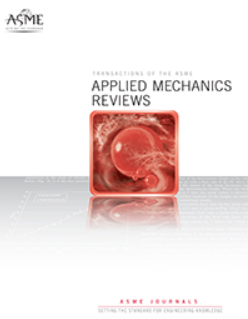Detailed Structural Analysis of Cylindrical Steel Tank Subjected to Various Seismic Peak Ground Values Using FSI Approach
IF 16.1
1区 工程技术
Q1 MECHANICS
引用次数: 0
Abstract
The seismic analysis of ground-supported cylindrical steel tanks subjected to lateral harmonic displacement loadings has been carried out. This paper numerically evaluates the structural response of various tank geometries due to resonant seismic sloshing. The numerical investigation is performed using a two-way fluid structural interaction approach that couples computational fluid dynamics analysis with finite element transient structural analysis. The results of the analysis have been validated using Seismic Design Code (Eurocode 8, part 4). Regarding tank aspect ratio (H/D), five geometries covering slender, medium, and broad structures are analyzed under ten harmonic base excitations. All the geometries are excited at their first convective frequency, whose shape and magnitude are evaluated using modal analysis. The seismic response curves have been developed for each tank model, which reveal the complex and peculiar structural response. It is observed from the tanks’ seismic response that they undergo three transitional stress zones named safe, yielding, and failure zones. The critical loadings and failure duration have also been evaluated for each tank model. This will help to avoid future structural damage by designing liquid-containing structures based on evaluated seismic failure loads.用FSI方法对不同地震峰值下的圆柱钢储罐进行详细结构分析
对地面支撑圆柱钢储罐在横向谐波位移荷载作用下的抗震性能进行了分析。本文对不同形状的储罐在地震晃动作用下的结构响应进行了数值计算。数值研究采用流体-结构双向相互作用方法,将计算流体动力学分析与有限元瞬态结构分析相结合。分析结果已通过抗震设计规范(Eurocode 8, part 4)进行验证。关于储罐长径比(H/D),在十次谐波基激励下分析了细长、中等和宽结构的五种几何形状。所有的几何形状都在它们的第一个对流频率处被激发,其形状和大小用模态分析来评估。对每一种储罐模型的地震反应曲线进行了分析,揭示了储罐结构的复杂和特殊的地震反应。从储罐的地震反应可以看出,储罐经历了安全区、屈服区和破坏区三个过渡应力区。对每个油箱模型的临界载荷和失效持续时间也进行了评估。这将有助于通过设计基于评估地震破坏载荷的含液结构来避免未来的结构损坏。
本文章由计算机程序翻译,如有差异,请以英文原文为准。
求助全文
约1分钟内获得全文
求助全文
来源期刊
CiteScore
28.20
自引率
0.70%
发文量
13
审稿时长
>12 weeks
期刊介绍:
Applied Mechanics Reviews (AMR) is an international review journal that serves as a premier venue for dissemination of material across all subdisciplines of applied mechanics and engineering science, including fluid and solid mechanics, heat transfer, dynamics and vibration, and applications.AMR provides an archival repository for state-of-the-art and retrospective survey articles and reviews of research areas and curricular developments. The journal invites commentary on research and education policy in different countries. The journal also invites original tutorial and educational material in applied mechanics targeting non-specialist audiences, including undergraduate and K-12 students.

 求助内容:
求助内容: 应助结果提醒方式:
应助结果提醒方式:


